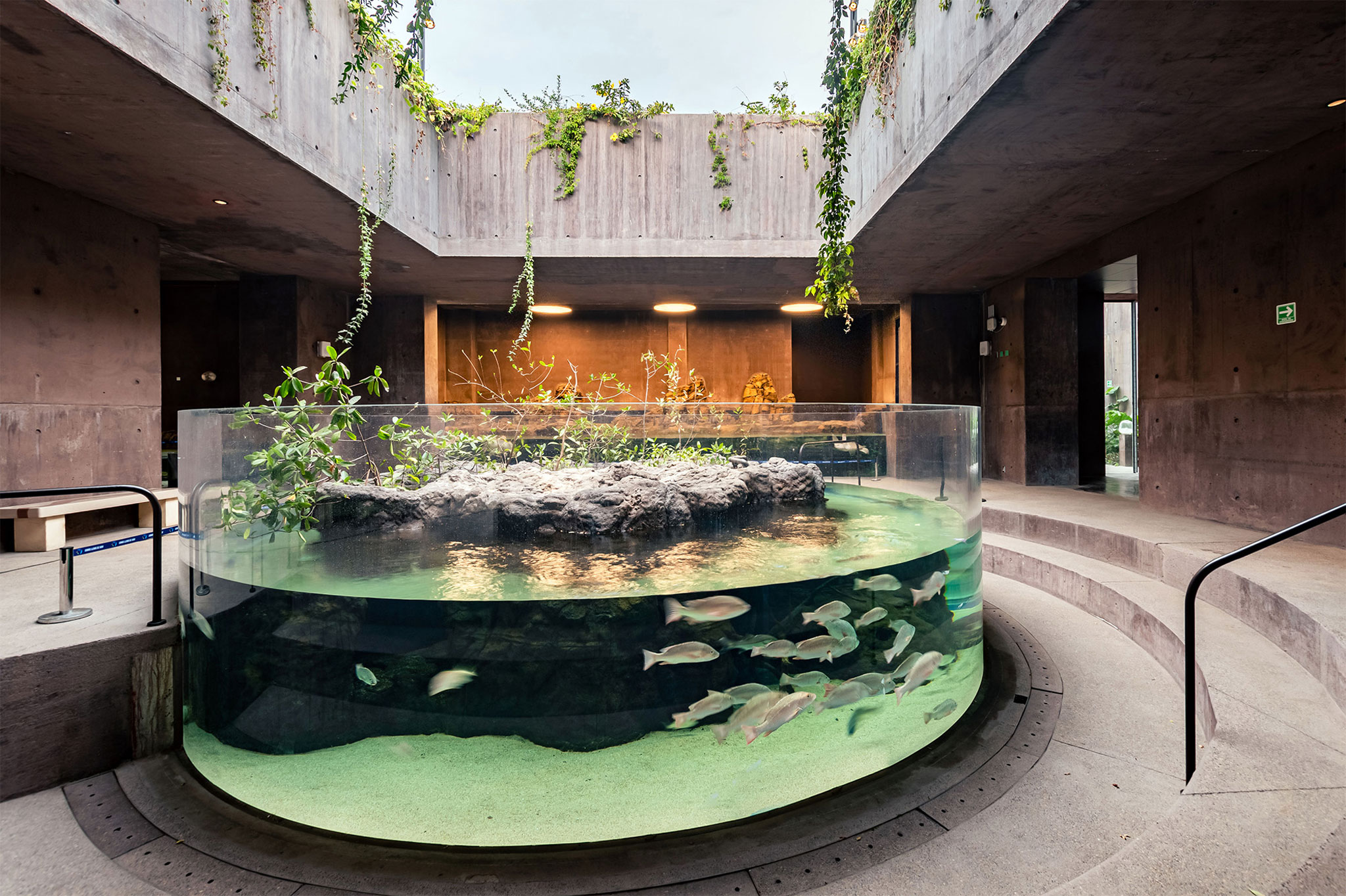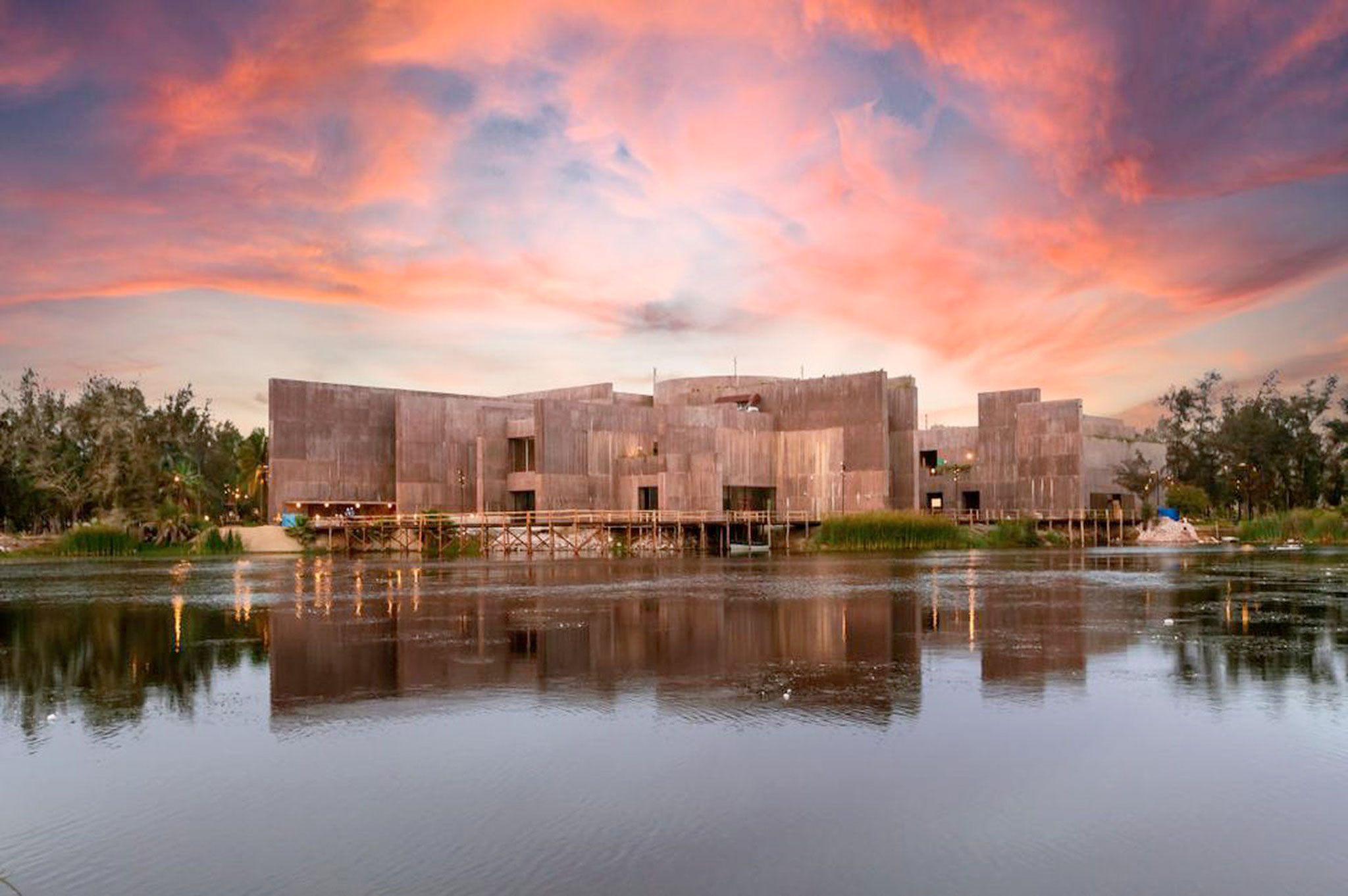The aquarium seeks to immerse the visitor in the natural world through the route of the building from the upper level to the lower plaza in three large habitats (land, coast, and sea), developing in parallel a series of laboratories that take advantage of the tanks and their inhabitants. to investigate and learn more about marine ecosystems. The Center is orthogonal, rational, functional, and flexible, with exposed concrete walls up to 22.5 meters high arranged on an area of 13,000 square meters, as if it were a painting by Piet Mondrian.
A scheme that, despite its impressive scale, allows spaces, structure, envelope, facilities, and integration with the environment to be resolved in a unitary and simultaneous way, creating something similar to the remains of an archaeological site that Bilbao describes as "a ruin that we have occupied."

Aquarium on the shores of the Sea of Cortez by Tatiana Bilbao. Imagen courtesy of Acuario Mazatlán.
The project has three levels. The ground floor, where the different reception and facilities spaces are located, the first floor, where we find the access plaza, and the second floor, with the exhibition support area and changing rooms for the staff. Both the surroundings of the building and its interior have growing nature, seeking contact between interior and exterior.
However, given the high entry prices for local residents, the building still has a long way to go to become an integrated piece in the social fabric of the city and be just an attraction for wealthy tourists. On the other hand, the alleged flexibility proposed in the project seems to clash with the necessary mobility controls and relationships with the stressed animals inside.

Aquarium on the shores of the Sea of Cortez by Tatiana Bilbao. Photograph by Iwan Baan.
Project description by Tatiana Bilbao
The project is part of the regeneration program for the Mazatlan Central Park. The intention is to complement the public, natural, and cultural areas of great social interest, marked by the quality and uniqueness of the overall intervention. The project will offer a complete experience of the marine ecosystems of the Sea of Cortez, as well as the terrestrial ecosystems of its shores.
The proposed building is the place where nature, both marine and terrestrial, meets architecture and the world of human beings. Nature lives and grows around and inside the building, giving the project identity, a sense of belonging to the place, and making the experience unique and complete. As a trigger for the space, an orthogonal, rational, functional, and flexible structure is proposed, with identity and belonging to the place where it is implanted. It simultaneously solves spaces, structures, envelopes, installations, and integration with the environment. Programmatic, functional, and service walls and installations extend irregularly into the surroundings, integrating with the surrounding landscape and providing structural stability to the building. The project seeks to increase the surface area of contact between the interior and exterior, blurring the boundaries between them and allowing for greater interaction.
Aquarium on the shores of the Sea of Cortez by Tatiana Bilbao. Imagen courtesy of Acuario Mazatlán.
The intention of the project is to immerse the visitor in the natural world through the journey of the extended exterior public space from the surroundings to the top of the building, and then descend to the central public access plaza from where visitors will begin their exhibition journey. From this plaza, visitors can access each of the exhibition ecosystems, open sea, coasts, land, and forest, as well as educational programs such as an auditorium and public laboratory. The exhibition experience can begin with any of the ecosystems.
The visitor can follow the exhibition continuously and flexibly, as the sequence of spaces communicates the programs continuously and at the same time transversely and in continuous contact with the exterior natural environment.
The project is developed on three levels. The first, is at the ground floor level, where the administrative and staff areas, reception of school groups, part of the public services, and a large part of the marine life conservation and support facilities, as well as centralized general facilities, are located. On the next level, the first floor, the general access plaza, exhibition, and public services are located. Above the previous level, in only one sector of the floor, is the area of support and attention to the large tanks of the exhibition, with complementary programs of changing rooms, toilets, and equipment for the maintenance personnel of the tanks and visitors for immersion in the oceanic tank. On this floor are the remaining facilities and equipment for marine life support.






































































